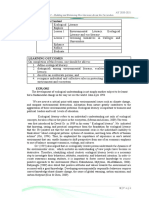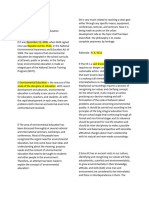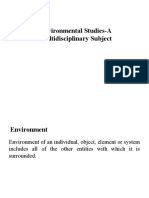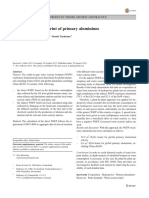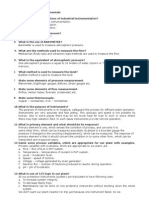Understanding Environment
Uploaded by
LucijaRomićUnderstanding Environment
Uploaded by
LucijaRomićSee discussions, stats, and author profiles for this publication at: https://www.researchgate.
net/publication/257028941
Understanding Environment
Article in Current science · July 2005
CITATION READS
1 973
2 authors, including:
T V Ramachandra
Indian Institute of Science
959 PUBLICATIONS 6,005 CITATIONS
SEE PROFILE
Some of the authors of this publication are also working on these related projects:
Renewable Energy Potential Assessment View project
Blue Carbon and Global Warming View project
All content following this page was uploaded by T V Ramachandra on 21 May 2014.
The user has requested enhancement of the downloaded file.
BOOK REVIEWS
Understanding Environment. Kiran B. on Sustainable Development at Zoharbex human influences, incorporating an ex-
Chhokar, Mamata Pandya and Meena in 2002, have drawn the attention of amination of economics, culture, political
Raghunathan (eds). Sage Publications India people around the globe to the condition structure and social equity as well as
Pvt Ltd, B-42, Panchsheel Enclave, New of our environment. In order to achieve the natural processes and systems. Ultimately,
Delhi 110 017. 2004. 331 pp. Price: Rs 280. goals of sustainable development, people the goal of environmental education is to
need to become aware of the environmental develop an environmentally literate public.
issues and acquire background information It needs to address the connection bet-
The life-supporting systems of the bio- to enable them to make and influence de- ween our conception and practice of edu-
sphere are being threatened due to defor- cisions. Environmental education is thus cation and our relationship as human
estation, destruction of habitats, overuse concerned with attitude towards and de- cultures to life-sustaining ecological sys-
of energy resources and environmental cisions about environment quality, with tems. For each environmental issue there
pollution. Changes in the earth’s climate, informed management of resources, and are many perspectives and much uncer-
decline and deterioration of natural re- with the ethical considerations that relate tainty. Environmental education cultivates
sources, accumulation of waste products, to these. Recognizing the importance of the ability to recognize uncertainty, envi-
soil exhaustion and destruction of ecosys- environmental education at all levels, the sion alternative scenarios, and adapt to
tems, are already apparent. Anthropogenic Supreme Court ordered that a course on changing conditions and information.
activities coupled with the burgeoning environment be made mandatory at the The knowledge, skill and mindset trans-
human population are responsible for the undergraduate level to sensitize the youth late into a citizenry that is better able to
loss of a large number of life forms; nu- to environmental issues and concerns. address its common problems and take
merous important plant and animal spe- According to the Supreme Court directive, advantage of opportunities, whether envi-
cies are on the verge of extinction, while the University Grants Commission intro- ronmental concerns are involved or not.
others are threatened or are vulnerable. In duced a six-month compulsory environ- Environmental issues make better sense
order to bring about sustainable resource mental course in all universities and when one can understand them in the
conservation and management, it is essential colleges during the academic year 2004– context of one’s own cognitive sphere.
to adopt different approaches for manag- 05. Environmental education focusing on real-
ing the ecosystem and biodiversity. To The declaration of the decade for Edu- world contexts and issues often begins
arrest the process of degradation and cation for Sustainable Development (ESD) close to home, encouraging learners to
species loss requires specialized solutions beginning 2005, by the United Nations forge connections with and understand
and an understanding of ecological proc- has provided further impetus. The goal is their immediate surroundings. The aware-
esses. Human beings have been inter- to create a sustainable world through ac- ness, knowledge and skills needed for
ested in ecology since the beginning of tive participation of citizens. Thus, ESD these local connections and understand-
civilization. Even our ancient scriptures is seen as a process that develops vision, ings provide a base for moving out into
have included practices and values related builds capacity, and empowers to make larger systems, broader issues, and a more
with ecological and environmental con- changes in human societies. Education sophisticated comprehension of causes,
servation. India is one of the mega diver- has a pivotal role to play in achieving a connections and consequences.
sity countries with Vavilovian centres of sustainable economy and society. The di- The book under review by Centre for
origin and diversification of cultivated lemma that an educator faces today, is that, Environment Education (CEE) conceptu-
plants, and endowed with rich traditional by and large, academic institutions try to alizes the environment as a multidimen-
knowledge system. Currently, it is even teach everyone to accept the economic sional complex living system and explains
more critical than ever before, for humankind system and to succeed within it. Unfor- the interlinkages among various func-
as a whole to have a clear understanding tunately, that success pretty much guar- tional components of the system. Begin-
of environmental concerns and to follow antees the accelerated blighting of the ning with basic concepts, 13 chapters
sustainable development practices. The planet and all living organisms, without cover a wide range of topics as well as
need for sustainable development is a key exception. The cognitive and cultural pedagogical approaches (questions, exer-
to the future of humankind. The degrada- separation of ‘ecology and environment’ cises, etc.) that help in sensitizing readers
tion of our environment is linked to con- from the human enterprise, has led to to environmental issues and concerns.
tinuing problems of pollution, loss of forest, large scale degradation and depletion of The chapters have a useful collection of
solid waste disposal, and issues related to natural resources. The guiding ideology references, so that students can acquaint
economic productivity, and national as well needed to learn and teach sustainability themselves with the literature. The publi-
as ecological security. The increasing levels is an orientation that emphasizes conserv- cation examines basic ideas of pedagogy
of global warming, depletion of the ozone ing cultural values, beliefs and practices and demands real thought on the part of
layer and a serious loss of biodiversity that contribute to sustainable relation- the reader. Here, the reader is presented
have also made everyone aware of growing ships with the environment. Perhaps the with instructional systems that consider
environmental concerns. Environmental best way to see if institutions of education performance-based learning (self-learning
management has gained momentum in have begun to develop ecologically is to and evaluation: questions and exercises).
recent years, with the initiatives focusing determine whether or not they acknowl- Readers find themselves mobilizing a
on managing environmental hazards and edge, in their structure, pedagogy and curri- cluster of skills that together move them
preventing possible disasters. culum. towards competency development. The
The United Nations Conference on Envi- Environmental education would help publication should be on the reading list
ronment and Development held in Rio De recognize the importance of investigating of university education dealing with this
Janeiro in 1992, and the World Summit the environment within the context of subject. For those working in this field,
206 CURRENT SCIENCE, VOL. 89, NO. 1, 10 JULY 2005
BOOK REVIEWS
the path is made easier with this timely series of field identification papers in menclature have been sufficient. Some of
publication by CEE. Cobra during 1997, which were again an the sketches of amphibian species that
exceptional attempt in that period. In seem to be computer morphing of colour
T. V. RAMACHANDRA1,* popularizing the subject, the structure photographs into black and white, do not
A. V. NAGARATHNA2 and contents of the book are good and reveal much about the species. This
come out of the vast experiences and in- could have been substituted with photo-
1
Energy and Wetlands Research Group, depth knowledge of the author in amphi- graphs that would aid in easy identifica-
Centre for Ecological Sciences, bian research. As the author himself ad- tion. Similarly, sketches of tadpoles
Indian Institute of Science, mits, this book is written keeping in mind along with the adult without relative sizes
Bangalore 560 012, India the students and amateur naturalists. It does not seem to help students in the
2
Biodiversity Unit, probes and compels the young minds into field, as the tadpoles grow in the begin-
Jawaharlal Nehru Centre for Advanced the field of research, especially while ning (increase in size) and undergo ret-
Scientific Research, Jakkur, dealing with the suggested students’ pro- rogressive metamorphosis (reduced size)
Bangalore 560 064, India jects. Such an approach by a senior re- before turning into adults. This is more
*e-mail: cestvr@ces.iisc.ernet.in searcher highlights the openness of the evident in the tadpole sketches of Rana
author about the subject and also empha- curtipes, Rana aurantiaca, Nyctibatra-
sizes the current research attitude that chus major and Euphlyctis hexadactylus.
requires more openness to share informa- I do personally agree that when the live
tion (more so to the younger generation). specimen is photographed, it is difficult
All the chapters have been written in a to keep a scale, and moreover this will
crisp and lucid manner, and are certainly tarnish the reality of the picture. But as
not loaded with details on anatomy, physio- the intention of the book is to make both
logy and developmental biology, etc. of students as well as amateurs alike iden-
typical subject books, but have instead tify the amphibian, sketches without rela-
provided what is relevant to present-day tive size hardly serve the purpose. The
research in the field. Suggested reading femoral glands in N. major are sketched
provides ample scope to the reader to go closer to the groin; in reality it is further
beyond the book. Keys to the species below and near the vent portion. Even
have been dealt with nicely with the in- such a minor error has great impact dur-
Amphibians of Peninsular India. R. J.
clusion of related taxa, life history, local ing field identification.
Ranjit Daniels. Universities Press (India)
names and remarks along with field Good quality photographs are the best
Pvt Ltd, 3-5-819, Hyderguda, Hyderabad
characters, diagnostic features, habits, part of the book (except one from the author
500 029. 2005. 268 pp. Price: Rs 315.
habitats and distribution. This has encom- on Euphlycitis cyanophlyctis); however,
passed almost all the information pertain- they stand completely isolated without
Frogs and toads have always fascinated ing to field identification of a species, any linkages to the text part. Inclusion of
man through the ages, dating back to Man- which was earlier more fragmented pieces glossary of terminology would have been
dukya Upanishad of the Vedic ages to the of information. an added advantage to students. Distribu-
recent discoveries in the Western Ghats. Though the book does lack the unique tion information would have been more
More technically known as ‘amphibians’ style of the author, which was prevalent impressive if it had maps of peninsular
(Greek equivalent for their biphasic life in his earlier papers and books, it is more India. A sentence about trap stealing in
stages as tadpoles and adults), these in- lucid. A few typographical errors (e.g. in the field has stressed the extremities one
clude caecilians, salamanders, newts, and p. 4, Rhinametridae, instead Rhinatremati- might face in the field conditions. At the
sirens. Amphibians are in serious scientific dae) still persist in the book. Combining same time bringing in India into the issue
contention over the last decade for at various existing names with their syno- may not have been right, especially when
least two main reasons. One being far more nyms has added more confusion than the nationality and national pride are serious
crucial, pertaining to their viable exis- purpose for which it was written. As an issues in young minds. Such sentences
tence as there are alarming indications of example, the species account of Hoplo- could have been avoided by the author.
decline in their global population, and the batrachus tigerinus has been detailed in There is no doubt that this book will
other on the frequent discoveries from bio- p. 188. The synonyms of this species in- go a long way as a pioneering field guide
diversity hotspot regions like Sri Lanka clude Rana malabarica, which is a sepa- to the amphibians in the peninsular region
and the Western Ghats of India, empha- rate species by itself. This will lead to and will be a recommended copy for both
sizing the linkages of phylogeography, identity conflict of the species, as there is students and amateurs.
evolution, etc. a separate description of Rana mala-
This book by Daniels, has landed in the barica on p. 233. One might think that H. K. V. GURURAJA
stands at a right time, when more and tigerinus and R. malabarica are the same
more researchers are getting into the species with two different names, which
field of herpetology with a fewer number in a real sense is not true. The title for the Energy and Wetlands Research Group,
of experienced researchers remaining in sketches is really cumbersome and lists Centre for Ecological Sciences,
many common names (similar to that of Indian Institute of Science,
it (or at least in this part of the globe).
synonyms as mentioned earlier). Instead Bangalore 560 012, India
Indeed the book is a much-awaited one
of listing, the single name with its no- e-mail: gururaj@ces.iisc.ernet.in
on amphibians, as the author did write a
CURRENT SCIENCE, VOL. 89, NO. 1, 10 JULY 2005 207
View publication stats
You might also like
- Design and Development of A Three Storey Dormitory Building100% (3)Design and Development of A Three Storey Dormitory Building109 pages
- Understanding Environment: Current Science July 2005No ratings yetUnderstanding Environment: Current Science July 20053 pages
- Understanding Environment: Current Science July 2005No ratings yetUnderstanding Environment: Current Science July 20053 pages
- Tenedero, Joannabel T. - BSED Math III (M5)No ratings yetTenedero, Joannabel T. - BSED Math III (M5)6 pages
- Historical Context of Sustainable Concepts_juanita s. AparenteNo ratings yetHistorical Context of Sustainable Concepts_juanita s. Aparente12 pages
- "Greening of Education" - Ecological EducationNo ratings yet"Greening of Education" - Ecological Education2 pages
- EE Materials GL - Ee - Materials - CompleteNo ratings yetEE Materials GL - Ee - Materials - Complete30 pages
- 01 Unit I Environmental Studies-A Multidisciplinary SubjectNo ratings yet01 Unit I Environmental Studies-A Multidisciplinary Subject52 pages
- Information Education Campaign For Ecological Solid Waste ManagementNo ratings yetInformation Education Campaign For Ecological Solid Waste Management9 pages
- Chapter 1 - Introduction To Environmental EducationNo ratings yetChapter 1 - Introduction To Environmental Education5 pages
- GCC 212 Environmental Education - Draft NotesNo ratings yetGCC 212 Environmental Education - Draft Notes83 pages
- Module 10: ECOLITERACY: Learning OutcomesNo ratings yetModule 10: ECOLITERACY: Learning Outcomes10 pages
- Curricular and Co-Curricular Dimensions of Environmental EducationNo ratings yetCurricular and Co-Curricular Dimensions of Environmental Education5 pages
- (Document Subtitle) : Unique Number: 308798No ratings yet(Document Subtitle) : Unique Number: 3087989 pages
- 7 - PDFsam - Visualizing Environmental Science - 5th Ed - (2017)No ratings yet7 - PDFsam - Visualizing Environmental Science - 5th Ed - (2017)1 page
- Environmental Education and Public Awareness: July 2006No ratings yetEnvironmental Education and Public Awareness: July 200611 pages
- Environmental Education For Sustainable Development: Empowering Future GenerationsNo ratings yetEnvironmental Education For Sustainable Development: Empowering Future Generations9 pages
- We Care A Lot: Formative Research For A Social Marketing Campaign To Promote School-Based RecyclingNo ratings yetWe Care A Lot: Formative Research For A Social Marketing Campaign To Promote School-Based Recycling9 pages
- 01 Unit I Environmental Studies-A Multidisciplinary SubjectNo ratings yet01 Unit I Environmental Studies-A Multidisciplinary Subject50 pages
- Environmental Education For Teachers of Primary Schools - 2No ratings yetEnvironmental Education For Teachers of Primary Schools - 223 pages
- Environmental Management Sustainable DevelopmentNo ratings yetEnvironmental Management Sustainable Development5 pages
- Environment Systems and Decisions Volume 22 Issue 4 2002 (Doi 10.1023 - A - 1020766914456) M. Kassas - Environmental Education - Biodiversity PDFNo ratings yetEnvironment Systems and Decisions Volume 22 Issue 4 2002 (Doi 10.1023 - A - 1020766914456) M. Kassas - Environmental Education - Biodiversity PDF7 pages
- Cox Proportional-Hazards Regression For Survival Data: John Fox 15 June 2008 (Small Corrections)No ratings yetCox Proportional-Hazards Regression For Survival Data: John Fox 15 June 2008 (Small Corrections)18 pages
- Furosemide Summary Report Committee Veterinary Medicinal Products enNo ratings yetFurosemide Summary Report Committee Veterinary Medicinal Products en9 pages
- Testing & Commissioning Procedure For Start Up of Diesel Generator Genset - Best Editable Construction QHSE Documentation PortalNo ratings yetTesting & Commissioning Procedure For Start Up of Diesel Generator Genset - Best Editable Construction QHSE Documentation Portal7 pages
- EL CICLO DE LA VIDA DE LOS RODAMIENTOS SKF - Ayude A Sus Rodamientos A Alcanzar Su Vidaútil MáximaNo ratings yetEL CICLO DE LA VIDA DE LOS RODAMIENTOS SKF - Ayude A Sus Rodamientos A Alcanzar Su Vidaútil Máxima22 pages
- Water Scarcity Footprint of Primary Aluminium: Lca of Metals and Metal Products: Theory, Method and PracticeNo ratings yetWater Scarcity Footprint of Primary Aluminium: Lca of Metals and Metal Products: Theory, Method and Practice11 pages
- Ulusoy HMH24-04 Incoming/Outgoing Switchgear With Circuit Breaker User Manual100% (1)Ulusoy HMH24-04 Incoming/Outgoing Switchgear With Circuit Breaker User Manual16 pages
- KCET 2025 Physics Electric Potential & Capacitance PYQsNo ratings yetKCET 2025 Physics Electric Potential & Capacitance PYQs36 pages
- Complete Download Pipeline integrity assurance a practical approach 1st Edition Michael Mcmanus PDF All Chapters100% (7)Complete Download Pipeline integrity assurance a practical approach 1st Edition Michael Mcmanus PDF All Chapters38 pages
- Chapter 2: Properties of Fluids: Eric G. PatersonNo ratings yetChapter 2: Properties of Fluids: Eric G. Paterson30 pages
- Energy Security and Management of Bangladesh (Petroleum Prospect)No ratings yetEnergy Security and Management of Bangladesh (Petroleum Prospect)4 pages
- Physics Challenge For Teachers and Students: Solutions To January 2007 ChallengeNo ratings yetPhysics Challenge For Teachers and Students: Solutions To January 2007 Challenge2 pages
- Barometer Is Used To Measure Atmospheric PressureNo ratings yetBarometer Is Used To Measure Atmospheric Pressure14 pages
- POWER QUALITY AND FACTS Question Paper 21 22No ratings yetPOWER QUALITY AND FACTS Question Paper 21 223 pages
- Chapter 8 - Mechanical Properties of Metals - Week 6&7100% (1)Chapter 8 - Mechanical Properties of Metals - Week 6&740 pages
- MR - SLIM With Heat Pump Lineup Catalogue: InverterNo ratings yetMR - SLIM With Heat Pump Lineup Catalogue: Inverter20 pages
